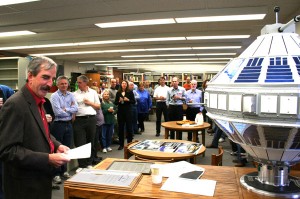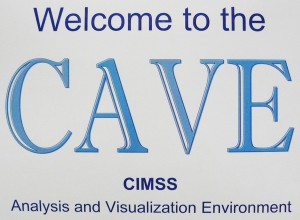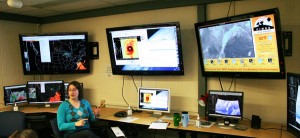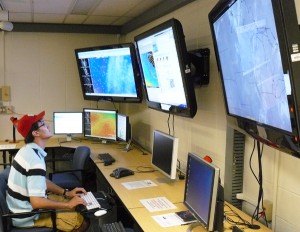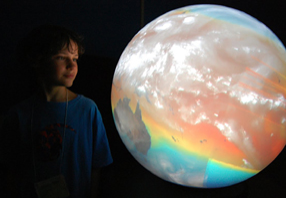Monthly News Summary – October 2009
- Governor Proclaims “Explorer 7 Day”
- Wayne Feltz to Present on “Wednesday Nite at the Lab”
- Exploring The Cave
- 3D Weather Globe Continues To Amaze and Educate
- SSEC Emergency Preparedness Lauded
- Glacier Edge Elementary 2nd Graders Wowed by CIMSS Applets
- Bill Hibbard Contributes to Emmy Award-Winning Broadcast
- New Appointments
- Projects and Publications
Governor Doyle Proclaims “Explorer 7 Day”
The 50th anniversary of the launch of the Explorer 7 satellite was commemorated by Governor Doyle with a proclamation declaring October 13, 2009, as “Explorer 7 Day.”
In a ceremony held at the AOS Building’s Schwerdtfeger Library, Hank Revercomb, the Director of the University of Wisconsin-Madison Space Science and Engineering Center, read the Governor’s proclamation before a full-scale model of the original satellite.
Hank Revercomb prepares to read Governor Doyle’s proclamation.
The text of Governor Doyle’s proclamation:
| A PROCLAMATIONWHEREAS, the first successful meteorological satellite instrument to measure the thermal radiation balance of the Earth was launched October 13, 1959, on NASA’s Explorer 7 satellite in support of the International Geophysical Year;WHEREAS, Dr. Verner E. Suomi, Dr. Robert J. Parent, and their colleagues at the University of Wisconsin-Madison, Space Science and Engineering Center, designed, built, and successfully implemented the thermal radiation experiment aboard Explorer 7, thus initiating the study of the Earth’s weather and climate from satellites;
WHEREAS, the 50-year anniversary of the Explorer 7 launch will be commemorated on Monday, November 2, 2009, as part of the Geostationary Operational Environmental Satellite (GOES) Users’ Conference to be held in Madison, Wisconsin; NOW, THEREFORE, I, Jim Doyle, Governor of the State of Wisconsin, do declare the day of October 13, 2009, EXPLORER 7 DAY in the State of Wisconsin and commend this observance to all citizens. |
Further celebrations of the launch of Explorer 7, which carried the first successful orbital climate study experiment into space will be held in conjunction with the 6th Annual GOES User Conference in Madison, Wisconsin.
Wayne Feltz to Present on “Wednesday Nite at the Lab”
Wayne Feltz will present an “Overview of Satellite-based Aviation Applications for Detection of Thunderstorms, Turbulence, and Volcanic Ash” for Wednesday Nite @ The Lab (WN@TL) in the main auditorium of the Biotechnology Center at 7 pm, Wednesday, October 28, 2009.
His seminar will describe how the University of Wisconsin-Madison Cooperative Institute for Meteorological Satellite Studies (CIMSS) Satellite Nowcasting and Aviation APplication (SNAAP) team is heavily involved in research to develop satellite-based nowcasting tools (0-3 hour forecast) for improving aviation weather forecasting. Current areas of research focus on satellite detection of aviation hazards such as convection, turbulence, and volcanic ash using current and future weather satellite systems.
WN@TL is jointly organized by the Wisconsin Alumni Association, by the UW-Madison Osher Lifelong Learning Institute, and by the Science Alliance @ UW-Madison. Presenters give a 45-50 minute talk and then engage with the participants in a discussion. Participants tend to be active retirees (25-50 people), with people also viewing the presentation remotely through a live webfeed.
More information about WN@TL and their schedule is available online.
On October 9, 2009, Room 248 of the AOS Building officially became the “Cave” – the CIMSS Analysis and Visualization Environment. Equipped with two high-end Linux boxes and a Mac Pro unit driving several monitors, including three 52” wall-mounted giants, the Cave provides audio-visual access for viewing the latest high-tech graphics and dynamical weather displays.
Many different applications and feeds are available, including AWIPS (the National Weather Service’s visualization tool), McIDAS-X and McIDAS-V (data analysis and visualization tools), MS Office (on the Mac) and even cable television. A roof-top camera feed will be added soon.
Jessica Staude and Jordan Gerth demonstrate the multiple monitors, feeds, and software packages available in the Cave.
Although time in the Cave can be reserved (via Maria Vasys), walk-ins are encouraged. Check the white board in the Cave for scheduled events.
3D Weather Globe Continues To Amaze and Educate
SSEC’s 3D Weather Globe recently returned from two months at the Milwaukee Public Museum where visitors to the IMAX and Planetarium Theater could select from an extensive menu of weather and climate topics to interact and learn from SSEC data displayed as global animations.
The highly educational spherical display system was acquired in March 2008 through a Baldwin Endowment Grant awarded to Rick Kohrs and Margaret Mooney who wanted to showcase SSEC remote sensing data on a 3D surface, similar to NOAA’s “Science on a Sphere” exhibit
Demonstrations and programs are conducted regularly for campus visitors, however, the exhibit will be also be central to the upcoming celebration of the 50th anniversary of Explorer 7, the first meteorological satellite mission, before being featured at the 2010 meeting of the American Meteorological Society in Atlanta next January.
SSEC Emergency Preparedness Lauded
A Note from John LaLande:
Hi.
I wanted to pass along a compliment. I attended an Emergency Preparedness/ CPR & AED class last night at the Pyle Center that was free for University staff members. I was surprised by how many of the employees in attendance said their building had no Occupant Emergency Plan (OEP) and/or no Automated External Defibrillator (AED). We’ve had both here at SSEC for some time now.
The Lieutenant from University Police who organized the training said that they had run into roadblocks at many buildings/departments around campus where the building managers said they were too busy to work with UPD on creating an OEP.
I talked with the Lieutenant after class and when I told him I worked at SSEC he said this was his favorite building on campus to work with, no doubt thanks to the proactiveness and professionalism of our building management and safety group. I have to say, it impressed me to see how far ahead of the curve we are compared to some other buildings and departments on campus.
Regards, John
Glacier Edge Elementary 2nd Graders Wowed by CIMSS Applets
Tim Olander visited the Glacier Edge Elementary School in Verona on October 8 and “blew away” two classes of 2nd graders with the JAVA applets (written by Tom Whittaker) on the CIMSS Applets page and the WeatherWise Applets page.
Olander focused on the hurricane, tornado, lightning, and baseball applets, but the students explored the other available applets as well.
Quoting Tim’s restrained comments: “The kids loved them! These applets are a wonderful thing!!!!”
Bill Hibbard Contributes to Emmy Award-Winning Broadcast
Bill Hibbard was interviewed as part of the “Matter and Beyond,” a television program which explores the ethical and spiritual dimensions of science and technology. The 26-minute program entitled “In Our Image and Likeness: Exploring the Quest to Create Human-Like Intelligence and Beings” won a local Emmy in the category of health and science. The episode was produced by the New Jersey-based Ebru Television Network.
Chris Velden Elected to AMS Hurricane Committee: The American Meteorological Society (AMS) Scientific Technical Advisory Committee (STAC) on Hurricanes and Tropical Meteorology has elected Cooperative Institute for Meteorological Satellite Studies (CIMSS) scientist Christopher Velden as a new member. The service term is 1 January 2010 through 31 December 2012.
VHRR Cloud Climate Project Accepted by WMO Panel: The executive panel of the World Meteorological Organization’s Sustained Coordinated Processing of Environmental Satellite Data for Climate Monitoring (SCOPE-CM) initiative has accepted an Advanced Very High Resolution Radiometer (AVHRR) cloud climatology project coordinated by Andrew Heidinger. A total of five initial projects were accepted into the SCOPE-CM initiative. The AVHRR cloud project also involves several European scientists.
A manuscript entitled “A Comparison of Meteorological Observations from South Pole Station before and after Installation of a New Instrument Suite” was published by the Journal of Atmospheric and Oceanic Technology, American Meteorological Society. The paper’s authors were L.M. Keller, K.A. Baker, M.A. Lazzara (AMRC) and J. Gallagher.

